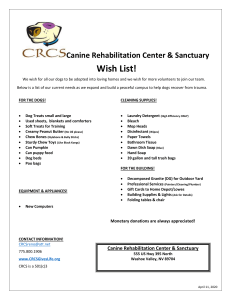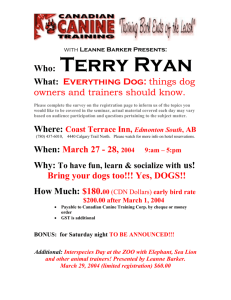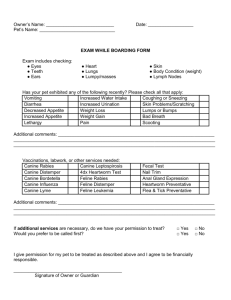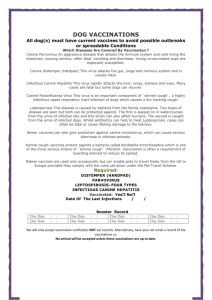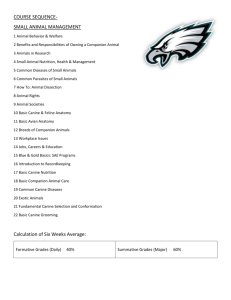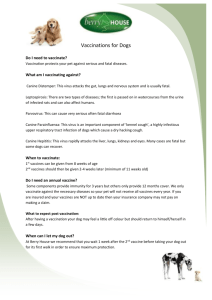infectious_canine_tracheobronchitis
advertisement
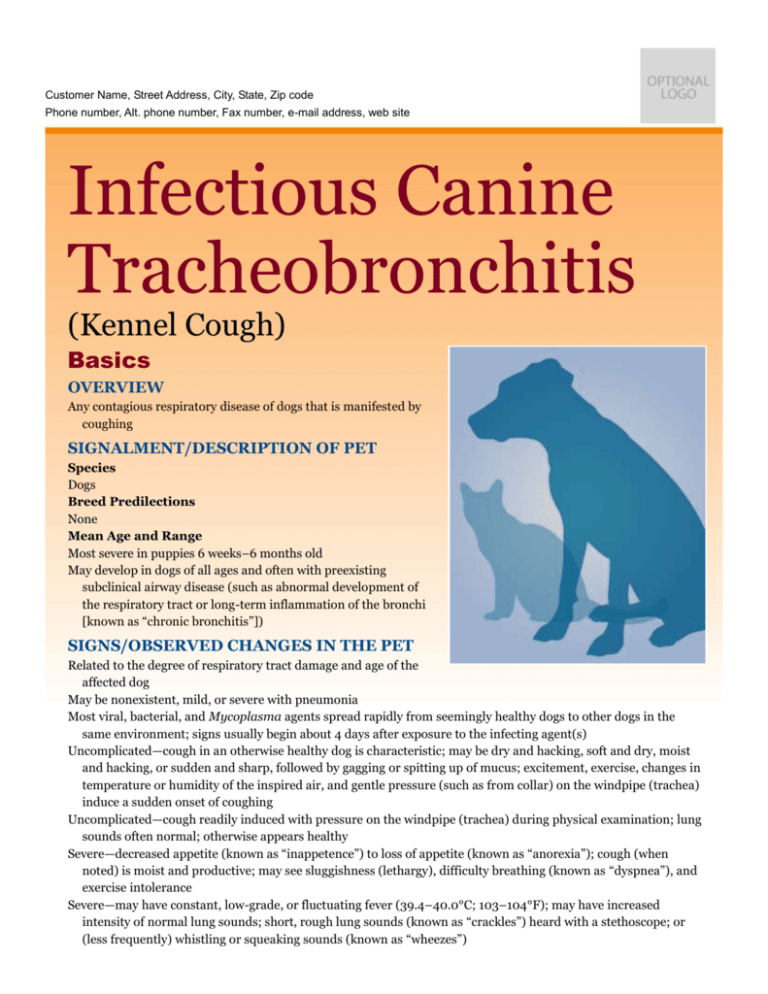
Customer Name, Street Address, City, State, Zip code Phone number, Alt. phone number, Fax number, e-mail address, web site Infectious Canine Tracheobronchitis (Kennel Cough) Basics OVERVIEW Any contagious respiratory disease of dogs that is manifested by coughing SIGNALMENT/DESCRIPTION OF PET Species Dogs Breed Predilections None Mean Age and Range Most severe in puppies 6 weeks–6 months old May develop in dogs of all ages and often with preexisting subclinical airway disease (such as abnormal development of the respiratory tract or long-term inflammation of the bronchi [known as “chronic bronchitis”]) SIGNS/OBSERVED CHANGES IN THE PET Related to the degree of respiratory tract damage and age of the affected dog May be nonexistent, mild, or severe with pneumonia Most viral, bacterial, and Mycoplasma agents spread rapidly from seemingly healthy dogs to other dogs in the same environment; signs usually begin about 4 days after exposure to the infecting agent(s) Uncomplicated—cough in an otherwise healthy dog is characteristic; may be dry and hacking, soft and dry, moist and hacking, or sudden and sharp, followed by gagging or spitting up of mucus; excitement, exercise, changes in temperature or humidity of the inspired air, and gentle pressure (such as from collar) on the windpipe (trachea) induce a sudden onset of coughing Uncomplicated—cough readily induced with pressure on the windpipe (trachea) during physical examination; lung sounds often normal; otherwise appears healthy Severe—decreased appetite (known as “inappetence”) to loss of appetite (known as “anorexia”); cough (when noted) is moist and productive; may see sluggishness (lethargy), difficulty breathing (known as “dyspnea”), and exercise intolerance Severe—may have constant, low-grade, or fluctuating fever (39.4–40.0°C; 103–104°F); may have increased intensity of normal lung sounds; short, rough lung sounds (known as “crackles”) heard with a stethoscope; or (less frequently) whistling or squeaking sounds (known as “wheezes”) CAUSES Viral—canine distemper virus; canine adenovirus-2; canine parainfluenza virus; canine adenovirus-1; canine respiratory coronavirus; canine reovirus type 1, 2, or 3; canine herpesvirus-1; canine influenza virus Canine adenovirus-2 and canine parainfluenza virus may damage the lining cells of the respiratory tract to such an extent that invasion by various bacteria and Mycoplasma cause severe airway disease Bacterial—Bordetella bronchiseptica, (with no other respiratory disease-causing agents) produces clinical signs indistinguishable from those of other bacterial causes; Pseudomonas, Escherichia coli, Klebsiella, Pasteurella, Streptococcus, Mycoplasma, and other species equally likely RISK FACTORS Dogs housed with multiple other dogs, such as pet shops, humane society shelters, research facilities, and boarding and training kennels Housing with less than ideal hygienic conditions; overcrowding conditions Preexisting subclinical airway disease, such as abnormal development of the respiratory tract or long-term inflammation of the bronchi (chronic bronchitis) Treatment HEALTH CARE Outpatient—strongly recommended for uncomplicated disease Inpatient—strongly recommended for complicated disease and/or pneumonia Fluid administration—indicated for complicated disease and/or pneumonia ACTIVITY Enforce rest—for at least 14–21 days with uncomplicated disease; for at least the duration of x-ray evidence of pneumonia in severely affected dogs DIET Good-quality canned or dry commercial food Medications Medications presented in this section are intended to provide general information about possible treatment. The treatment for a particular condition may evolve as medical advances are made; therefore, the medications should not be considered as all inclusive Antibiotic therapy—amoxicillin/clavulanic acid or doxycycline—initial treatment of uncomplicated disease Antibiotic therapy—cephalosporin (such as cefazolin) with gentamicin or amikacin or enrofloxacin—usually effective for severe pneumonia; continue antibiotic therapy for at least 10 days beyond resolution of pneumonia as seen on x-rays (radiographs) Bordetella. bronchiseptica or other resistant bacteria—some antibiotics may not reach adequate levels in the lower respiratory tract to be effective, so administration of these antibiotics by mouth or injection may have limited effectiveness; treating with a fine medicated spray (known as “nebulization”) containing kanamycin, gentamicin, or polymyxin B maybe effective, when administered daily for 3–5 days; also administer systemic antibiotics in dogs with lung disease Cough suppressants (such as butorphanol or hydrocodone)—effective in decreasing the dry, nonproductive cough, not associated with bacterial infectionDrugs to increase the openings in the bronchi and bronchioles (known as “bronchodilators,” such as extended-release theophylline)—may be used to control narrowing of the bronchi and bronchioles due to contraction of smooth muscles in the walls of these airways (known as “bronchospasm”); bronchospasm is detected clinically by whistling or squeaking sounds (wheezes) Follow-Up Care PATIENT MONITORING Uncomplicated disease—should respond to treatment in 10–14 days; if the pet continues to cough 14 days or more after adequate treatment, dog should be evaluated again by your pet's veterinarian Severe disease—repeat chest x-rays (radiographs) until at least 14 days beyond resolution of all clinical signs PREVENTIONS AND AVOIDANCE Shedding of the causative virus and/or bacteria of infectious canine tracheobronchitis (kennel cough) in respiratory secretions of dogs undoubtedly accounts for the persistence of this problem in kennels, animal shelters, boarding facilities, and veterinary hospitals; thorough cleaning and disinfecting of kennels is necessary to control spread of disease-causing organisms Viral and Bacterial Vaccines Available to control disease caused by the principal infectious agents involved Bordetella bronchiseptica and canine parainfluenza virus vaccine—may vaccinate puppies using a vaccine applied into the nose (intranasal vaccine) as early as 2–4 weeks of age, without interference from maternal antibody; follow-up vaccinations should be administered as directed by your pet's veterinarian; may vaccinate mature dogs with a one-dose intranasal vaccination (at the same time as their puppies or when they receive other vaccinations, as directed by your pet's veterinarian) Inactivated injectable Bordetella bronchiseptica vaccine—administered as two doses, 2–4 weeks apart; initial vaccination of puppies is recommended at or about 6–8 weeks of age; administer second vaccine at 4 months of age Inactivated canine influenza virus vaccine is available EXPECTED COURSE AND PROGNOSIS Natural course of uncomplicated disease, if untreated—10–14 days; simple restriction of exercise and prevention of excitement shortens the course Typical course of severe disease—2–6 weeks; may be fatal in pets that develop severe pneumonia, affecting multiple lung lobes Key Points Isolate the dog from other pets; infected dogs can transmit the disease-causing virus and/or bacteria before onset of clinical signs and afterward until immunity develops Dogs with uncomplicated disease should respond to treatment in 10–14 days Once infection spreads in a kennel, it can be controlled by removing all dogs from the premises for 1–2 weeks and disinfecting with commonly used chemicals, such as sodium hypochlorite (bleach; 1:30 dilution), chlorhexidine, or benzalkonium (NOTE: never mix disinfectants; follow directions for use carefully) Enter notes here Blackwell's Five-Minute Veterinary Consult: Canine and Feline, Fifth Edition, Larry P. Tilley and Francis W.K. Smith, Jr. © 2011 John Wiley & Sons, Inc.
